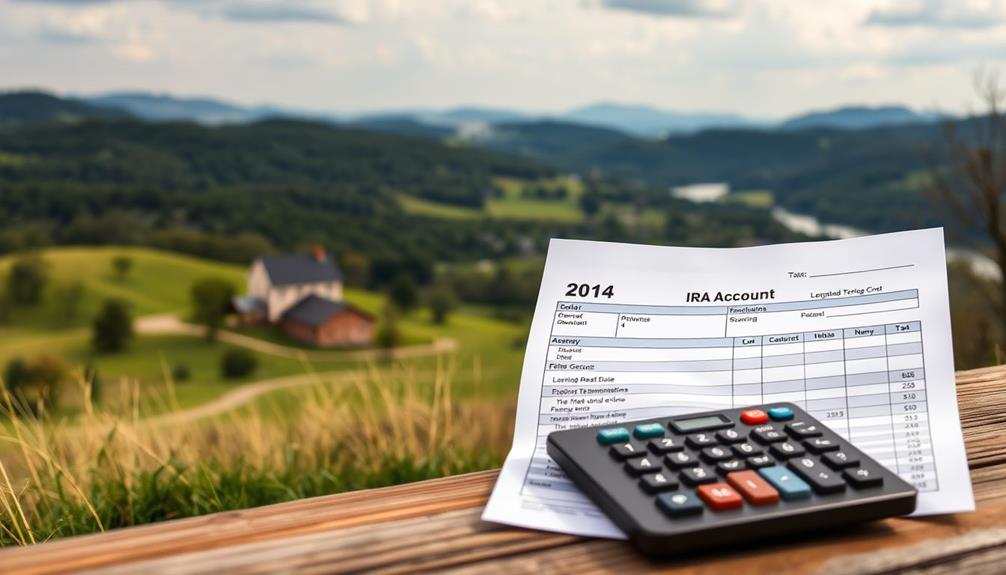Withdrawing funds from your Individual Retirement Account (IRA) in New York can have state tax implications that should be carefully considered. In general, these withdrawals are subject to state taxes as regular income, with rates ranging from 4% to 10.9%. Individuals who are 59 and a half years or older may be able to exclude the first $20,000 of their retirement income from taxes, but this exclusion does not apply to lump-sum distributions. Nonresidents are only taxed on distributions that are connected to services provided in New York. Understanding these specific details can help you strategize and optimize your tax situation. For a more comprehensive understanding of exemptions and required minimum distributions, there is a wealth of information available to explore.
Key Takeaways
- IRA withdrawals in New York are taxed as regular income, with rates ranging from 4% to 10.9%, depending on the income bracket.
- Individuals aged 59½ or older can exempt the first $20,000 of retirement income from state tax, applicable to both periodic and lump-sum distributions.
- Social Security benefits are fully exempt from New York state taxation, providing additional financial relief for retirees.
- Nonresidents are taxed only on IRA distributions related to services performed in New York, with the age exemption still applicable.
- Failure to take Required Minimum Distributions (RMDs) by the deadline incurs a 50% penalty on the amount not withdrawn.
Overview of State Tax Implications

State tax implications for IRA withdrawals can often catch retirees off guard. In New York, when you take distributions from traditional IRAs, those amounts are subject to New York state tax, with income tax rates ranging from 4% to 10.9% based on your income level.
However, if you're aged 59½ or older, you can benefit from an age exemption, allowing you to exempt the first $20,000 of your retirement income from state taxation. This exemption includes any IRA withdrawals and qualified plan distributions.
For retirees relying on Social Security benefits, there's good news: those benefits are exempt from New York state taxation, providing added financial relief.
If you're a nonresident, remember that IRA distributions are taxable only if they stem from services performed in New York. In such cases, you can still claim the $20,000 exemption if you're 59½ or older.
When it comes to lump-sum distributions, the tax implications can differ markedly. Special averaging rules apply, and if those distributions are from work performed entirely in New York, you won't qualify for the $20,000 exclusion.
Always consider these factors to avoid unexpected tax burdens.
Required Minimum Distributions

As you navigate the landscape of retirement income, understanding Required Minimum Distributions (RMDs) is essential for managing your IRA withdrawals effectively.
In New York State, you must begin taking RMDs by April 1st of the year following your 73rd birthday. The IRS provides a Uniform Lifetime Table to determine your distribution period, unless your spouse is a beneficiary and more than 10 years younger, in which case you'd use the Ordinary Joint Life and Last Survivor Annuities Table.
To calculate your RMD, divide your account balance as of December 31st of the previous year by the distribution period factor from the applicable table.
It's vital to remember that the IRS imposes hefty penalties—50% of the amount not withdrawn—if you fail to take your RMDs as required.
Keep in mind that excess distributions taken in one year don't count toward future RMDs; you can't offset your required amounts.
Understanding these rules helps you manage both your taxable amounts for federal income tax and non-taxable amounts, ensuring compliance and minimizing penalties related to your retirement plan.
Withdrawing From Traditional NYCE IRA

Withdrawing funds from a Traditional NYCE IRA requires careful attention to the process and potential tax implications. You can initiate a withdrawal at any time, but understanding how these distributions work is essential for your retirement planning.
To withdraw, you'll need to submit a Traditional NYCE IRA Withdrawal Form, which allows for both full and partial distributions.
Here are some key points to evaluate:
- Periodic Payments: You can schedule withdrawals on a monthly, quarterly, semi-annual, or annual basis.
- Special Circumstances: If your withdrawal is due to death, disability, or divorce, contact the NYCE IRA Administrative Office for specific instructions.
- Tax Implications: Keep in mind that any distributions may be subject to income tax in New York.
For assistance and more information regarding your withdrawal options, don't hesitate to call the NYCE IRA at (212) 306-7760 or 888-IRA-NYCE.
Tax Treatment of Withdrawals

Understanding the tax treatment of withdrawals from a Traditional IRA is essential for effective retirement planning. In New York, your IRA withdrawals are fully taxable as regular income.
However, if you're aged 59½ or older, you can take advantage of an exemption that allows the first $20,000 of your withdrawals to be tax-free. This exemption applies to both periodic payments and lump-sum distributions, and it's cumulative across various retirement plans.
Additionally, incorporating strategies like diversifying with Gold IRAs can provide a hedge against inflation, further enhancing your retirement planning.
As a New York resident, it's crucial to recognize that distributions from your IRA will contribute to your total income, which is subject to state income tax rates ranging from 4% to 10.9%.
If you're a nonresident, you'll only face taxes on IRA withdrawals related to services performed in New York, and you can still benefit from the $20,000 exemption if you meet the age requirement.
Keep in mind that tax implications vary based on the type of retirement account. For instance, public pensions aren't taxed at the state level, unlike private retirement accounts.
Understanding these nuances can help you manage your retirement income more effectively.
State Tax Exemptions for Retirees

New York offers considerable tax exemptions for retirees, making it easier to stretch your retirement savings. If you're 59½ or older, you can exempt the first $20,000 of your retirement income, including IRA withdrawals, from state and city taxes. This exemption enhances your financial benefits and applies to cumulative distributions from various retirement plans.
To qualify for these state tax exemptions, keep in mind the following:
- You must receive your distributions in periodic payments, not as a lump sum.
- The exemption is also available for beneficiaries of deceased individuals, provided they meet the age requirement.
- This $20,000 exemption is in addition to the state income tax exemption for public retirement benefits received by New York government employees.
Understanding these tax implications can greatly impact your retirement strategy. By taking advantage of these exemptions, you can maximize your retirement income, allowing you to enjoy your golden years with less financial stress.
Frequently Asked Questions
Do I Pay State Tax on IRA Withdrawal?
Yes, you'll pay state tax on your IRA withdrawal. The amount's taxed as regular income, so it's essential to reflect on how this impacts your overall tax liability and plan your withdrawals accordingly.
Does NY State Tax Inherited IRA Distributions?
Yes, New York state does tax inherited IRA distributions. However, if you're 59½ or older, you can exclude the first $20,000 from state tax, easing your tax burden while steering through this financial landscape.
What Are the Tax Implications of Withdrawing From Ira?
When you withdraw from your IRA, you generally face income tax on the distribution. Depending on your age and contributions, some amounts might be exempt or partially taxable, so understanding your situation is essential.
Do I Have to Pay NY State Tax on My Pension?
When it comes to your pension, you're in the clear! New York exempts public pensions from state taxes, so you won't pay any taxes on those, keeping your hard-earned money where it belongs—your pocket.
Conclusion
Charting state tax implications for IRA withdrawals in New York can feel like sailing through choppy waters. By understanding the rules around required minimum distributions and how traditional NYCE IRA withdrawals are taxed, you can steer your finances toward calmer seas. Don't forget to explore potential exemptions available for retirees, as they might offer you a smoother journey. With the right knowledge, you can make informed decisions and keep your retirement savings intact.









